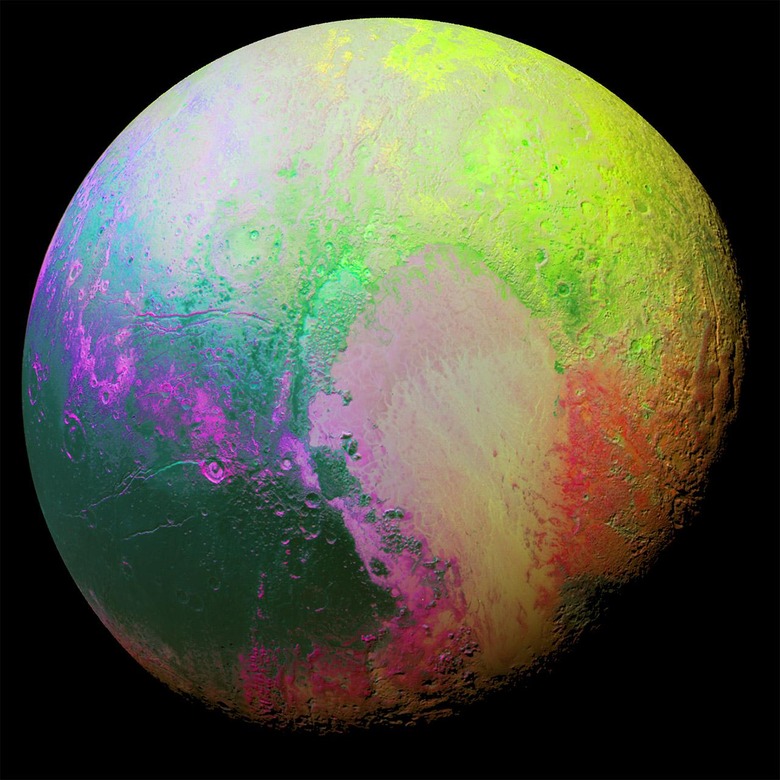NASA's News On Pluto: A New Underground Ocean
Signs point to an underground ocean on Pluto thanks to information gathered by NASA's New Horizons probe. While the probe passed Pluto in July of 2015, information continues to travel back to Earth even now. Researchers pore over the information gathered and turn up new revelations every day. While not every finding in the data sent back to our planet is worthy of a massive news story – this one certainly is.
According to a study published this week, scientists from the University of California Santa Cruz, the University of Maryland, and others show Pluto turning over a new leaf. A new leaf, that is, in our understanding of the universe and its possibilities. According to this paper, the reorientation of the nitrogen-covered basin Sputnik Planitia suggests a real-deal subsurface ocean under the surface of Pluto.
ABOVE: New Horizons scientists made this false color image of Pluto to highlight the subtle color differences between Pluto's distinct regions. Per NASA: "The image data were collected by the spacecraft's Ralph/MVIC color camera on July 14 at 11:11 AM UTC, from a range of 22,000 miles (35,000 kilometers). This image was presented by Will Grundy of the New Horizons' surface composition team on Nov. 9 at the Division for Planetary Sciences (DPS) meeting of the American Astronomical Society (AAS) in National Harbor, Maryland."

See a full-sized version of the image above at NASA. This image can be downloaded with the link in the lower right-hand side at 1850 x 1850 pixels and over 3MB in size. This is one of many photos of the planet available from NASA for free, thanks to your tax dollars.
Sputnik Planitia is the heart-shaped portion of the planet often shown in the lower right-hand corner of the image. This section is shown in the psychedelic-color image above, half in a sand-tan, half in red. Previous findings suggest that this impact region may have "tipped over" the planet.
The findings suggest that Sputnik Planitia sits close to the longitude of the planet's tidal axis and "may be an impact feature." This "may" alludes to features found in other similar basins found on planets throughout our Solar System. It's said that Pluto likely reorientated when the impact was formed.
The paper references Nimmo, F. & Matsuyama, I. Reorientation of icy satellites by impact basins. Geophys. Res. Lett. 34, L19203 (2007) to show how space bodies like Pluto have moved after impact. If tidal and rotational torques explain Sputnik Planitia's rise and location, then the feature should be more like a mountain than a dip. As it were, Sputnik Planitia is a rather large dip.
As the research paper says, "if Sputnik Planitia did indeed form as a result of an impact and if Pluto possesses a subsurface ocean, the required positive gravity anomaly would naturally result because of shell thinning and ocean uplift, followed by later modest nitrogen deposition." A positive gravity anomaly like this requires an "implausibly thick nitrogen layer" (40-kilometers+) unless a subsurface ocean exists.
"To prolong the lifetime of such a subsurface ocean to the present day and to maintain ocean uplift, a rigid, conductive water-ice shell is required," says the research paper. "Because nitrogen deposition is latitude-dependent, nitrogen loading and reorientation may have exhibited complex feedbacks."
For more information on this subject, have a peek at the publication Nature. There, the paper "Reorientation of Sputnik Planitia implies a subsurface ocean on Pluto" can be found with code doi:10.1038/nature20148 by authors F. Nimmo, D. P. Hamilton, W. B. McKinnon, et. all.
To see more awesome findings and spectacular photos from NASA's New Horizons journey toward, near, and past Pluto, hit up our New Horizons tag portal. This portal continues to expand, not only because of Pluto, but because of Planet X, as well. Some believe that a Planet X will be discovered with oddities galore, while others suggest that it'll be too small to be considered a planet at all.
